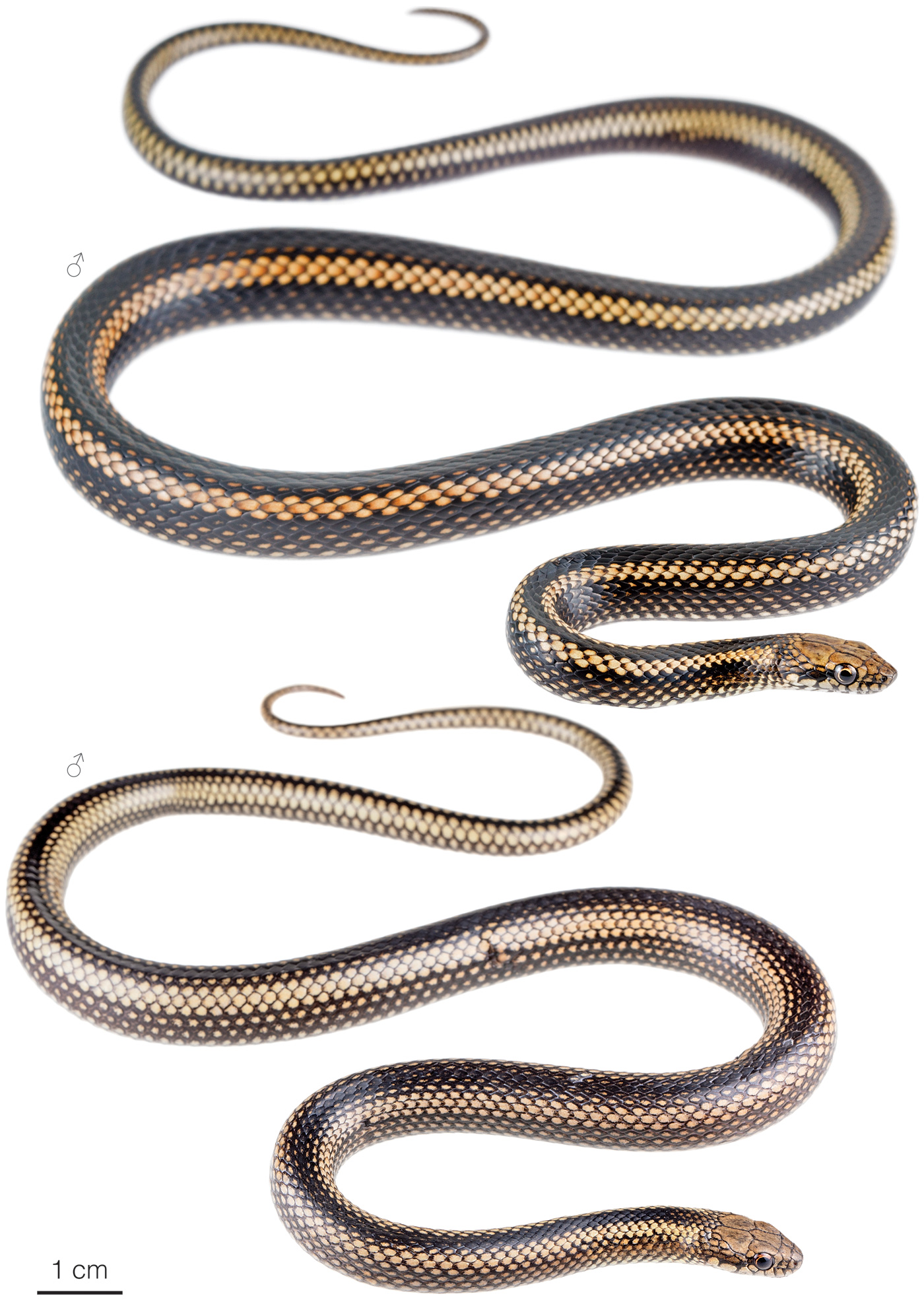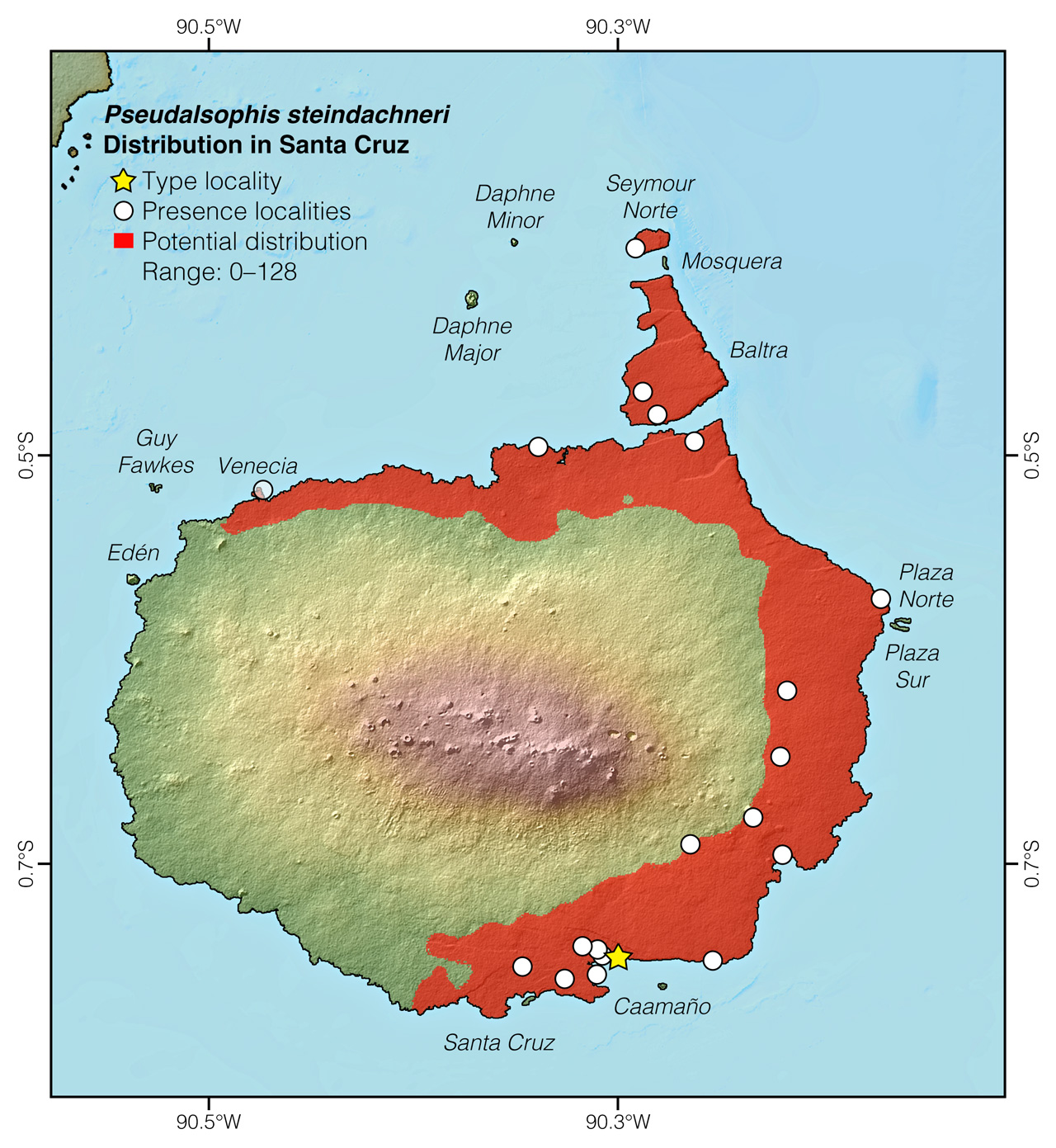Published October 10, 2019. Updated August 18, 2025. Open access. Peer-reviewed.
Painted Galápagos Racer (Pseudalsophis steindachneri)
Reptiles of Ecuador | Serpentes | Colubridae | Pseudalsophis steindachneri
English common name: Painted Galápagos Racer.
Spanish common names: Culebra pintada de Galápagos, culebra rayada de Galápagos.
Recognition: ♂♂ 61.2 cmMaximum distance from the snout to the tip of the tail. Snout–vent length=40.2 cm. ♀♀ 53.4 cmMaximum distance from the snout to the tip of the tail. Snout–vent length=36.8 cm..1,2 Pseudalsophis steindachneri is one of two snake species known to occur on Baltra, Santa Cruz, and Seymour Norte islands.2–4 It is characterized by having a black dorsum with pale goldenrod yellow dorsolateral bands and black flanks in which the center of each scale is bright golden yellow (Fig. 1).2–4 The head is brownish olive with black postocular streaks.2–4 This species differs from the co-occurring P. dorsalis by being smaller and having golden speckled lateral black bands.2

Figure 1: Individuals of Pseudalsophis steindachneri from Puerto Ayora, Santa Cruz Island, Galápagos, Ecuador.
Natural history: Pseudalsophis steindachneri is a comparatively common snake that occurs naturally in coastal volcanic rock areas, dry shrublands, dry grasslands, and seasonally dry forests.2 In Puerto Ayora, the species also ventures into rural gardens and peri-urban areas.2 Painted Galápagos Racers are active throughout the day, but usually not during hot midday hours. Their activity primarily occurs at ground level on bare soil or lava blocks,2 but semi-arboreal behavior on cacti and low shrubs has also been recorded.2,5 When not active, individuals hide in crevices or beneath loose tree bark.5 Galápagos racer snakes in general are mildly venomous, which means they are dangerous to small prey, but not to humans.4 The diet in P. steindachneri includes lizards (Microlophus indefatigabilis), geckos (Hemidactylus frenatus and Phyllodactylus galapagensis), snakes, and insects.6,7 There are recorded instances of predation on juveniles of this species by mockingbirds.6
Conservation: Endangered Considered to be facing a high risk of extinction in the near future..8 Pseudalsophis steindachneri is included in this category at the national level because the species’ extent of occurrence is estimated to be less than 500 km2 and anecdotal observations indicate the species is declining due to predation by feral cats.6,9 The Painted Racer is believed to have been nearly extirpated from Baltra and the populations of the co-occurring racer snake species P. dorsalis in Santa Cruz are severly depleted. Therefore, the status of both species should be monitored carefully.6,9
Distribution: Pseudalsophis steindachneri is endemic to an area of approximately 293 km2 across Baltra, Santa Cruz, and Seymour Norte islands in Galápagos, Ecuador (Figs 2, 3).

Figure 2: Distribution of Pseudalsophis steindachneri in Galápagos. See Appendix 1 for a complete list of the presence localities included in the map.

Figure 3: Distribution of Pseudalsophis steindachneri in Santa Cruz Island. The star corresponds to the type locality: Academy Bay. See Appendix 1 for a complete list of the presence localities included in the map.
Etymology: The generic name Pseudalsophis comes from the Greek words pseudo (=false) and Alsophis (a genus of Caribbean snakes), referring to the similarity between snakes of the two genera.1 The specific epithet steindachneri honors Franz Steindachner (1834–1919), a prolific Austrian zoologist who described hundreds of new species.2,3
See it in the wild: Like most snakes in Galápagos, Painted Galápagos Racers are secretive animals, but, with some luck, they can be seen at a rate of about once every few days along the trail leading from Puerto Ayora to Tortuga Bay, especially during the first hours after sunrise or right before sunset.
Special thanks to Lina Knuth-Winterfeldt for symbolically adopting the Painted Galápagos Racer and helping bring the Reptiles of Ecuador book project to life.
Click here to adopt a species.
Authors: Alejandro ArteagaaAffiliation: Fundación Khamai, Reserva Arlequín, Ecoruta Paseo del Quinde km 56, Santa Rosa de Mindo, Pichincha 171202, Ecuador. and Juan M GuayasaminbAffiliation: Universidad San Francisco de Quito, Quito, Ecuador.
Academic reviewers: Robert A ThomascAffiliation: Loyola University, New Orleans, United States. and Luis Ortiz-CatedraldAffiliation: Massey University, Palmerston North, New Zealand.
Photographer: Jose VieiraeAffiliation: Tropical Herping (TH), Quito, Ecuador.,fAffiliation: ExSitu, Quito, Ecuador.
How to cite? Arteaga A, Guayasamin JM (2025) Painted Galápagos Racer (Pseudalsophis steindachneri). In: Arteaga A, Bustamante L, Vieira J (Eds) Reptiles of Ecuador: Life in the middle of the world. Available from: www.reptilesofecuador.com. DOI: 10.47051/TAFY3079
Literature cited:
- Zaher H, Yánez-Muñoz MH, Rodrigues MT, Graboski R, Machado FA, Altamirano-Benavides M, Bonatto SL, Grazziotin FG (2018) Origin and hidden diversity within the poorly known Galápagos snake radiation (Serpentes: Dipsadidae). Systematics and Biodiversity 16: 614–642. DOI: 10.1080/14772000.2018.1478910
- Arteaga A, Bustamante L, Vieira J, Tapia W, Guayasamin JM (2019) Reptiles of the Galápagos: life on the Enchanted Islands. Tropical Herping, Quito, 208 pp. DOI: 10.47051/AQJU7348
- Van Denburgh J (1912) Expedition of the California Academy of Sciences to the Galápagos Islands, 1905-1906. IV. The snakes of the Galápagos Islands. Proceedings of the California Academy of Sciences 1: 323–374.
- Thomas RA (1997) Galápagos terrestrial snakes: biogeography and systematics. Herpetological Natural History 5: 19–40.
- Field notes, Reptiles of Ecuador book project.
- Cisneros-Heredia DF, Reyes-Puig C (2023) Natural history and conservation of the Galápagos snake radiation. In: Lillywhite HB, Martins M (Eds) Islands and snakes. Oxford University Press, 158–182. DOI: 10.1093/oso/9780197641521.003.0009
- Betancourt-Cargua L, Andrea C, Morejón-Jaramillo G, Pinto CM (2023) Updated diet of the Galápagos painted racer Pseudalsophis steindachneri (Van Denburgh, 1912) based on prey items retrieved from a damaged museum specimen. Herpetology Notes 16: 919–922.
- Carrillo E, Aldás A, Altamirano M, Ayala F, Cisneros-Heredia DF, Endara A, Márquez C, Morales M, Nogales F, Salvador P, Torres ML, Valencia J, Villamarín F, Yánez-Muñoz M, Zárate P (2005) Lista roja de los reptiles del Ecuador. Fundación Novum Millenium, Quito, 46 pp.
- Cisneros-Heredia DF, Márquez C (2017) Pseudalsophis steindachneri. The IUCN Red List of threatened species. Available from: www.iucnredlist.org. DOI: 10.2305/IUCN.UK.2017-2.RLTS.T190542A54447669.en
Appendix 1: Locality data used to create the distribution map of Pseudalsophis steindachneri in Ecuador (Fig. 2). Go to the section on symbols and abbreviations for a list of acronyms used. Asterisk (*) indicates type locality.
| Country | Province | Locality | Source |
| Ecuador | Galápagos | Academy Bay* | Van Denburgh 1912 |
| Ecuador | Galápagos | Baltra | Thomas 1997 |
| Ecuador | Galápagos | Canal de Itabaca | Cisneros-Heredia & Reyes-Puig 2023 |
| Ecuador | Galápagos | Casa de Cruz Marquez | Arteaga et al. 2019 |
| Ecuador | Galápagos | El Cascaja, 2 km S of | Cisneros-Heredia & Reyes-Puig 2023 |
| Ecuador | Galápagos | El Garrapatero | Arteaga et al. 2019 |
| Ecuador | Galápagos | Garrapatero, 10 km N of | Cisneros-Heredia & Reyes-Puig 2023 |
| Ecuador | Galápagos | Garrapatero, 4 km NW of | Cisneros-Heredia & Reyes-Puig 2023 |
| Ecuador | Galápagos | Garrapatero, 6 km N of | Cisneros-Heredia & Reyes-Puig 2023 |
| Ecuador | Galápagos | La Camiseta | Arteaga et al. 2019 |
| Ecuador | Galápagos | Las Bachas | iNaturalist; photo examined |
| Ecuador | Galápagos | Near Gordon Rocks | Fritts and Fritts 1982 |
| Ecuador | Galápagos | Old Baltra airport | Arteaga et al. 2019 |
| Ecuador | Galápagos | Playa de los alemanes | Arteaga et al. 2019 |
| Ecuador | Galápagos | Puerto Ayora | Arteaga et al. 2019 |
| Ecuador | Galápagos | Punta Núñez | Arteaga et al. 2019 |
| Ecuador | Galápagos | Seymour Norte | Arteaga et al. 2019 |
| Ecuador | Galápagos | Tortuga Bay trail | Arteaga et al. 2019 |
| Ecuador | Galápagos | Venecia | iNaturalist; photo examined |